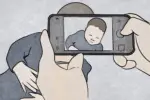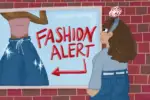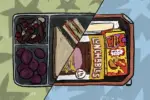Arguments against affluent people shopping in thrift stores first surfaced on TikTok during the summer of 2020, but the conversation on thrifting has since evolved. The app-wide debate — should people who can afford to shop elsewhere buy from thrift stores — became popular as Gen Z, or those born between the years of 1997 and 2012, sought out environmentally sustainable alternatives to fast fashion. Since thrifting is a relatively accessible trend, it allows a person’s socioeconomic class to be ignored. But doing so leads to the question: Should people with less money have the first pick when thrifting?
Thrifting became a trendy activity for young adults over the last few years due to thrift stores’ low prices and the exciting experience of hunting for clothes. You enter the shop, and the dusty scent of pre-owned clothes fills your nostrils. As you comb through every shirt, hat and accessory, a tinge of disappointment wells up within. Then, just when you think there’s nothing in the store worth purchasing, your hand grazes across a designer item in your size. The treasure hunt of shopping at a thrift store like Goodwill can make you feel as if you earned the item you found. Now, everyone who asks where you got that item can be met with the proud response, “I thrifted it.”
Despite the popularity of this indoor Easter egg hunt, there are some who warn of thrift store gentrification. A primary concern is that people who can afford to shop at other places will buy out the best items at thrift stores and then turn around and re-sell their thrifted items at an elevated price to make a profit.
TikTok creator @facingkc pointed to a trend where people would buy kids’ clothing from thrift stores and re-sell them for as much as $40 apiece. Her video generated over 47,000 likes as well as almost 400 comments, many of them echoing how difficult it is to find affordable clothing for children. Yet criticism over thrift store gentrification continues to target individuals and not the actual companies that perpetuate the issue.
https://www.tiktok.com/@facingkc/video/6852812999577701637?is_copy_url=1&is_from_webapp=v1
“The prices have skyrocketed in there and I couldn’t find a single good piece of clothing,” said another TikTok creator known as @wildtremella. In a TikTok video, she explained how a thrift store that she had frequented for “over ten years” now needs a security guard so that people will not steal from the store, and the usual 15% student discount was taken away because of the volume of sales to young customers. “I am one of eight children and growing up, that was the only place my family could get affordable clothing for us,” says @wildtremella. She concluded with a plea to “please shop responsibly.”
https://www.tiktok.com/@wildtremella/video/6948963143443926277?lang=en&is_copy_url=1&is_from_webapp=v1
While some argue that financially well-off individuals should leave thrift stores to those who cannot afford new clothes, others demand that more people shop secondhand. Fast fashion — the current model used by the fashion industry — causes significant clothing waste, not to mention wasted money on items that will only be in style for a couple of months. To shop sustainably means choosing to not participate in fast fashion and to buy things that have already been used or will last a long time.
TikTok creator @walmart.jenny.humprey argues that thrifting, regardless of socioeconomic standing, is a positive thing. In a video from last year, she described how she witnessed approximately 20 garbage bags of clothes get discarded every week as the solution to unsold merchandise. She said that the shelf life of the store’s items was three weeks; after that, it was thrown away. The creator encourages people to shop at thrift stores rather than at the mall in the hopes of reducing clothing waste.
@walmart.jenny.humprey Since everybody wants to talk about thrift store gentrification I thought I’d share my side as someone who worked at one
Adding onto that, the United States Environmental Protection Agency (EPA) estimates that only 14.7% of textiles were recycled in 2018, leaving 11.3 million tons in landfills. Clothing makes up a large percentage of waste every year, while just a small chunk is actually recycled. The reported amounts of waste generated by textiles are the backbone behind the arguments for thrifting, leading creators like @walmart.jenny.humprey to believe that the environmental impact of shopping secondhand is significant.
One content creator whose mindset shifted on the topic of thrift store gentrification is @imperfectidealist, a TikTok influencer whose videos focus on sustainability efforts. Like other creators, she was concerned about the re-selling of thrifted items, but at the end of 2020, she announced that she had changed her mind. She emphasized the number of clothes that go un-purchased, pointing back to the same EPA study other creators mentioned. She pushed back on the idea that thrift store gentrification is causing the rise in prices but instead directs her audience’s attention to the corporate stores that want people’s money.
Each thrift store company, whether it be Goodwill, Buffalo Exchange or The Salvation Army, stewards their merchandise differently; yet the TikTok debate continues, especially on the environmental side of the app, where individuals who are interested in sustainability efforts can hear both sides of the argument against thrifting.
One element of the debate that makes it complex is that people often argue with their personal priorities in mind. While one person is concerned about the ethics of re-selling thrifted items to make a profit, another is far more concerned with the environmental impact of constantly buying new clothes and would rather they be resold. There are also some people who analyze the economic implications of the situation, including the question of whether or not thrift store charities receive optimal funding. Because people are often concerned about different sides of the thrift store gentrification discussion, the fiery debate prevails.
















